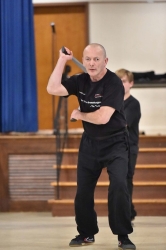
There are many ways to peel an onion. As you do, you go deeper until you get to the very core. This is the way all martial arts are meant to be taught and learned.
I will focus today (as I always do) on Kali. Even more specifically, Dekiti Tirsia Siradas Kali.
At the very beginning of your training, you will learn your 12 strikes using the Baston,(stick). These will give you the angles and target areas you will want to work with whenever you train. Work the right and left sides of the body as well as centerline strikes. You should focus on each strike as you would your front punch. Try and relate the whoosh of the Baston with the snap of a gi. You will see, just as it takes much practice.
Next, we need to learn the footwork, the key to Dekiti Tirsia Siradas. And it is true, it is the key. I’m 64 and spar with students a third of my age. I manage to keep up with them because of the footwork. If we take Superfoot Bill Wallace as an example (70+ years old), you can get a quick idea of the importance of footwork.
Now, these would be the outer layers of the martial arts onion. As experienced practitioners know, it takes much time and practice to perfect even these seemingly rudimentary tasks.
There is a saying that insanity is doing the same thing over and over and expecting a different result. I would have to disagree. I’ve been doing martial arts for almost 5 decades and I am getting the hang of a front punch, or a #1 strike in Dekiti Tirsia Siradas. This comes through countless repetitions, time and time and time again.
Let’s peel back the layers
The next layer we are going to hit will be structure. We need to build a good solid structure and at the same time make sure our opponent’s structure is compromised. Some quick and easy numbers to remember are 45 degrees and the opposite 135 degrees. These will give us the best structure. If we align our body properly as we do our defensive footwork,(45 degrees to our opponent.) as well as aligning our arm at the proper angle of 45*/135* this will give us the proper structure to control our opponent.
Timing is the next layer we want to unravel. As we start to move our bodies as well as our Baston or blade, we need to have only the best timing, whether for the attack or the defense. If we swing too early, our opponent will see our intent and will easily counter. The same applies if we swing too late, the moment will be lost and we will lose the advantage. When dealing with a blade, even the slightest miscalculation can be disastrous. When we use our timing to evade before our counter, we must be as accurate as we are on the attack. Proper timing can be used as a quick substitute for speed in an emergency situation, but by no means should one neglect their speed training. Footwork should always be used with split-second timing.
Yet another layer!
The last layer we will examine is probably the hardest one to achieve and take the most time to master. That would be sensible. By the mere touch of a hand or arm, you need to be able to ascertain the intent of your opponent. Feeling which way his body moves and being able to respond is one of the higher masteries of martial arts. When the opponent attacks with a blade or Baston, the mathematics of the martial artist combined with the feeling of the body to produce the desired result.
A quick explanation could be; that if you are attacked by someone much larger and you decide to stop the attack with a basic block, it may or may not end well. However, if you combine your power with your opponent’s power, “feeling his motion”, you can redirect his power putting you in a more advantageous position.
So as you can see, training Dekiti Tirsia Siradas Kali or any martial arts is not just a few classes to mastery. The arts have to be trained consistently. Learning is like peeling away the layers of an onion. On the street, we may not have the opportunity to ask for weight classes, although Tuhan Jerson Nene Tortal is a mere 5’ tall and is able to handle opponents much larger than he.
The good news is that training and peeling away the layers is part of the martial arts journey, a journey that can last a lifetime!
- The Martial Effectiveness of Drills in Filipino Martial Arts (FMA) - February 5, 2025
- The Resurgence of Traditional Martial Arts in Modern Mixed Martial Arts - January 7, 2025
- The Night Christmas Almost Died - December 21, 2024

Leave a Reply